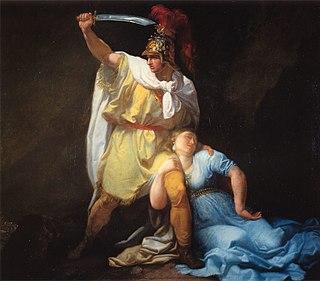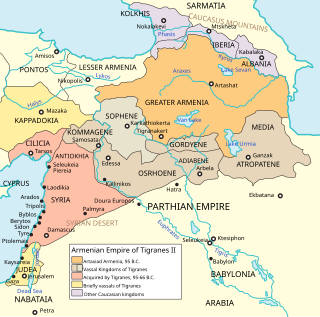Related Research Articles

The 70s was a decade that ran from January 1, AD 70, to December 31, AD 79.

The 80s was a decade that ran from January 1, AD 80, to December 31, AD 89.
AD 51 (LI) was a common year starting on Friday of the Julian calendar. At the time, it was known as the Year of the Consulship of Caesar and Scipio. The denomination AD 51 for this year has been used since the early medieval period, when the Anno Domini calendar era became the prevalent method in Europe for naming years.
AD 56 (LVI) was a leap year starting on Thursday of the Julian calendar. At the time, it was known in the Roman Empire as the Year of the Consulship of Saturninus and Scipio. The denomination AD 56 for this year has been used since the early medieval period, when the Anno Domini calendar era became the prevalent method in Europe for naming years.
The 140s decade ran from January 1, 140, to December 31, 149.
The 160s decade ran from January 1, 160, to December 31, 169.
The 190s decade ran from January 1, 190, to December 31, 199.
Year 147 (CXLVII) was a common year starting on Saturday of the Julian calendar. At the time, it was known as the Year of the Consulship of Messalinus and Largus. The denomination 147 for this year has been used since the early medieval period, when the Anno Domini calendar era became the prevalent method in Europe for naming years.

This article concerns the period 59 BC – 50 BC.

Year 208 (CCVIII) was a leap year starting on Friday of the Julian calendar. At the time, it was known as the Year of the Consulship of Aurelius and Geta. The denomination 208 for this year has been used since the early medieval period, when the Anno Domini calendar era became the prevalent method in Europe for naming years.
Year 54 BC was a year of the pre-Julian Roman calendar. At the time, it was known as the Year of the Consulship of Appius and Ahenobarbus. The denomination 54 BC for this year has been used since the early medieval period, when the Anno Domini calendar era became the prevalent method in Europe for naming years.

Vologases III was king of the Parthian Empire from 110 to 147. He was the son and successor of Pacorus II.

Vologases IV was King of Kings of the Parthian Empire from 147 to 191. He was the son of Mithridates V. Vologases spent the early years of his reign re-asserting Parthian control over the Kingdom of Characene. From 161 to 166, he waged war against the Roman Empire; although initially successful, conquering Armenia and Syria, he was eventually pushed back, briefly losing control of the Parthian capitals of Seleucia and Ctesiphon to the Romans. The Romans suffered heavy losses from a plague erupting from Seleucia in 166, forcing them to withdraw. The war ended soon afterward, with Vologases losing most of northern Mesopotamia to the Romans. He died in 191 and was succeeded by his son Vologases V.
The Arsacid dynasty, called the Arshakuni in Armenian, ruled the Kingdom of Armenia from 12 to 428 AD. The dynasty was a branch of the Arsacid dynasty of Parthia. Arsacid kings reigned intermittently throughout the chaotic years following the fall of the Artaxiad dynasty until 62, when Tiridates I, brother of Parthian King Vologases I, secured Arsacid rule in Armenia as a client king of Rome. However, he did not succeed in establishing his line on the throne, and various princes of different Arsacid lineages ruled until the accession of Vologases II, who succeeded in establishing his own line on the Armenian throne, which ruled the kingdom until its abolishment by the Sasanian Empire in 428.

The Parthian Empire, also known as the Arsacid Empire, was a major Iranian political and cultural power centered in ancient Iran from 247 BC to 224 AD. Its latter name comes from its founder, Arsaces I, who led the Parni tribe in conquering the region of Parthia in Iran's northeast, then a satrapy (province) under Andragoras, who was rebelling against the Seleucid Empire.

The war between the kingdoms of Iberia and Armenia is known chiefly through its description in Tacitus 'Annals.
The Roman–Parthian Wars were a series of conflicts between the Parthian Empire and the Roman Republic and Roman Empire. It was the first series of conflicts in what would be 682 years of Roman–Persian Wars.

The Parthian war of Caracalla was an unsuccessful campaign by the Roman Empire under Caracalla against the Parthian Empire in 216–17 AD. It was the climax of a four-year period, starting in 213, when Caracalla pursued a lengthy campaign in central and eastern Europe and the Near East. After intervening to overthrow rulers in client kingdoms adjoining Parthia, he invaded in 216 using an abortive wedding proposal to the Parthian king Artabanus's daughter as a casus belli. His forces carried out a campaign of massacres in the northern regions of the Parthian Empire before withdrawing to Asia Minor, where he was assassinated in April 217. The war was ended the following year after Parthian victory at the Battle of Nisibis, with the Romans paying a huge sum of war reparations to the Parthians.

Gaius Julius Sohaemus was a Roman client king of Armenia.
References
- ↑ Hopkins, Edward (March 28, 1998). "Chronological Listing of Parthian Rulers". Parthia. Retrieved November 20, 2023.
- ↑ Hopkins, Edward (March 28, 1998). "Vologases III". Parthia. Retrieved November 20, 2023.